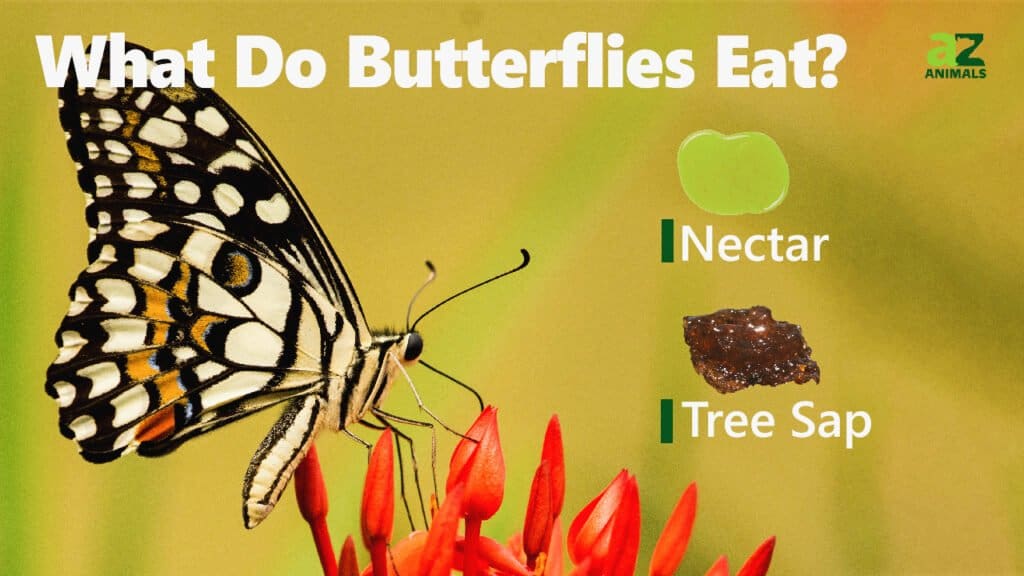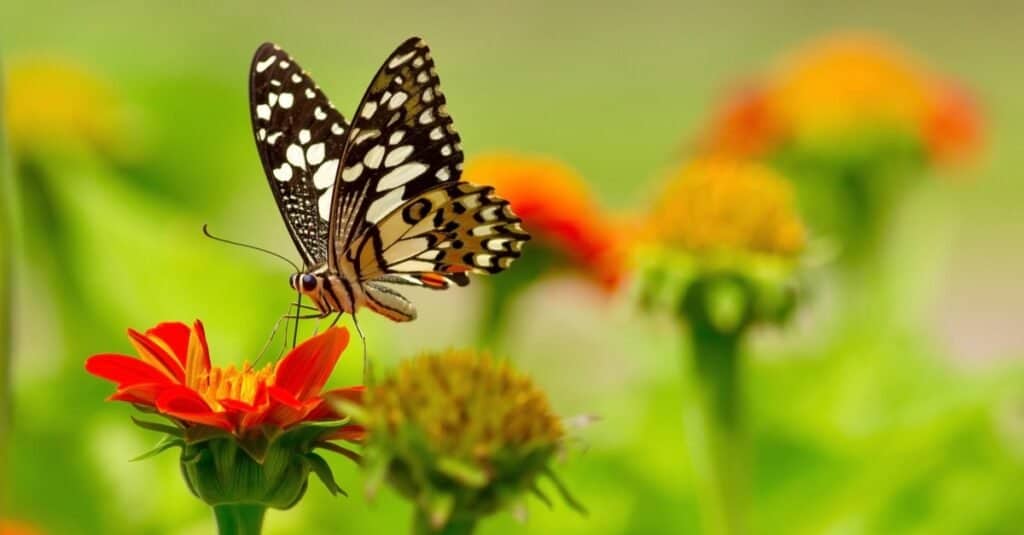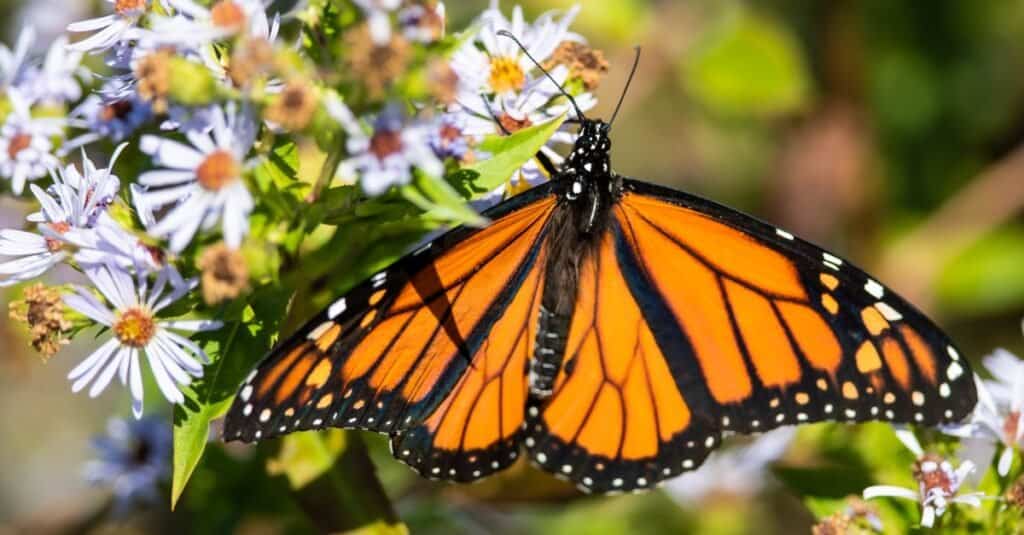
You may think butterflies look so small and delicate that they can barely eat anything. But, like all animals, butterflies need nourishment.
Their favorite food is sweet nectar from plants and flowers.
How and when do butterflies feed?
Read on to learn all about it.
Interesting Facts About How Butterflies Eat
Butterflies cannot bite or chew. They don’t have any teeth.
They use a long, tube like tongue to suck up nectar and other sweet and salty liquids like a straw. Butterflies also use their feet to taste the food that they’ve landed on.
Butterflies ingests substances such as nectar, sap, and even juice from rotting fruit.
Some other facts about a butterflies diet include:
- Butterflies love sugary foods.
- Some butterflies eat other insects.
- Moths and butterflies eat the same thing.
- Butterflies use a long feeding tube called a proboscis to eat.
- Butterflies like salty liquids, which is why they sometimes land on humans. They want to drink our sweat!
Butterflies
A butterfly is a flying insect with a small body and large, often colorful wings. Butterflies are closely related to moths, which also have wings that are large in proportion to their bodies and antennae.
Butterflies are insects that belong to the order Lepidoptera. This order includes moths.
The name Lepidoptera comes from the Greek words for wing and scale. Members of this order are the only insects that have scales on their wings.
This unusual feature sets them apart and gives them the unique looks that make them beautiful to our eyes.
Butterflies range in size from half an inch to more than four inches in wingspan. They come in every color and color combination of the rainbow.
Butterflies as well as all other insects have both a brain, a heart, and a nervous system.
How Can You Tell Moths and Butterflies Apart?
Moths and butterflies are members of the same family, and they share a family resemblance.
There are some key differences, however:
- Body shape: Butterflies have a long, slender thorax, and moths have thicker bodies.
- Fuzz: Moths often have a soft, fuzzy appearance that butterflies don’t have.
- Antennae: Moths have feathered antennae, and butterflies have slim, smooth ones.
- Activity: Most butterflies are diurnal, and moths are usually active at night.
- Colors: In general, butterflies are jewel-toned, and moths are gray, brown and other earthy colors.
Butterflies also tend to fold their wings vertically whereas moths tend to hold their wings differently. Butterflies are also larger and have more colorful patterns.
The colors of moths are usually dull compared to butterflies.
Do Moths and Butterflies Eat the Same Things?

©aDam Wildlife/Shutterstock.com
Yes, but there are a few differences.
For instance, the harvester butterfly (Feniseca tarquinius) can eat aphids. It’s the only butterfly that can eat other insects.
The zebra butterfly (Heliconius charithonia) can collect and eat pollen. There are no moths that eat other insects or pollen.
They also have different ways of eating.
A butterfly will sit or rest on its food source, but a moth usually hovers over its food.
How Butterflies Eat
Have you ever watched butterflies flitting around a garden? As they go from flower to flower, they are feeding.
Butterflies don’t have mouths or teeth. Each butterfly has a long extension called a proboscis.
This long extension looks like a slender straw that extends from the butterfly’s head. When the butterfly isn’t using it, the proboscis coils up into a ball.
When it’s time to eat, the butterfly approaches the food source and uncoils the proboscis.
The butterfly then inserts the feeding straw into the flower or other source of nectar. The long feeding straw makes it easy for a butterfly to reach deep inside a flower to draw out the nectar.
Where Do Butterflies Find Food?
Like most wild animals, butterflies are constantly foraging for food. There are many places they find it, but these are the most common.
- Flowers: Most butterflies get their nectar from flowers. They enjoy the nectars of both wild and domestic flowers.
- Rotting fruit: Fruit that’s fallen from a tree will turn liquid as it rots. Butterflies enjoy drinking this sweet fruit juice.
- Mud puddles: Muddy water is full of minerals that are important to butterfly nutrition. A group of butterflies gathered around a mud puddle is called a “puddle club.”
- Ditches: Butterflies need lots of liquids, and they will drink water from drainage ditches or gutters.
- Animal dung: When other animals eat fruit, they leave it in their dung. Many butterfly species are happy to drink the liquid surrounding their dung.
- Trees: Butterflies drink tree sap if they can’t find other liquids.
What Do Butterflies Eat?

©rck_953/Shutterstock.com
Butterflies mostly eat nectar and water.
Each butterfly species prefers a specific plant, but they will feed wherever food is available. Unlike caterpillars, they are not species-specific.
Some plants are popular among all types of butterflies.
If you want to attract butterflies to a garden, for instance, you will draw many different species with the following plants:
- Zinnia
- Butterfly bush
- Mexican sunflower
- Lantana
- Milkweed
Milkweed is also a popular nesting place for monarch butterflies.
Other flowers that butterflies enjoy drinking from include azaleas, coneflowers, clover, daisies, dandelions, honeysuckle, meadow flowers, snapdragons, and sunflowers.
In Search of Nectar
Like many wild animals, butterflies spend a lot of time foraging for food.
Butterflies are important pollinators, and many people enjoy seeing them in their gardens.
You can make your outdoor spaces more attractive to butterflies by planting nectar-producing flowers.
Next Up…
- Fear of Animals: The Big List – Most commonly feared animals include insects such as spiders, wasps, and bees. Slithering creatures are also some of the most feared animals.
- How Many Pandas Are Left in the World? – Pandas are among some of the most recognizable creatures on Earth. They are favored by many, but still continue to decline in population.
- Saint Berdoodle vs Sheepadoodle: What Are The Differences? – When it comes to picking the right breed of dog for you, some people know exactly what type they want and others don’t. Understanding the key differences between a Saint Berdoodle and a Sheepadoodle might help you decide.
The photo featured at the top of this post is © Marek Mierzejewski/Shutterstock.com
FAQs (Frequently Asked Questions)
What Do Caterpillars Eat?
Caterpillars eat leaves and twigs. Most caterpillars are species-specific, which means they only eat the leaves of specific trees. Once they grow into butterflies, however, they are less picky about the sources of their food.
The only caterpillar that eats other insects is the caterpillar of the harvester butterfly. Like the adult butterfly, it eats aphids. Harvesters are the only species of butterfly or caterpillar that eat other bugs.
How Can You Attract Butterflies and Moths?
If you want to attract moths and butterflies to your garden, start by planting flowers. There are many guides that tell you which butterflies are local to your area and which flowers are likely to attract them.
Here are some examples of specific species and the food or flower nectar they prefer.
- American copper: Daisy, dandelion, clover, and milkweed.
- Clouded sulfur: Clover, dandelion, milkweed, and daisy.
- Eastern tiger swallowtail: Bee balm, honeysuckle, and butterfly bush.
- Malachite: Rotting fruit, dung, and mud.
- Variegated fritillary: Meadow flowers and hibiscus.
You can also leave out small pieces of fruit. Choose fruits high in liquid content like watermelons, strawberries, oranges, and peaches.
What Is the Butterfly’s Primary Diet?
A butterfly’s diet is mostly liquids and sugar. Their primary food source is nectar. The only exceptions are harvester butterflies and zebra butterflies.
Are Butterflies Herbivores or Carnivores?
They are herbivores. With one exception, they don’t eat other animals.
Do Butterflies Have Teeth?
Butterflies don’t have teeth or tongues.
Thank you for reading! Have some feedback for us? Contact the AZ Animals editorial team.






